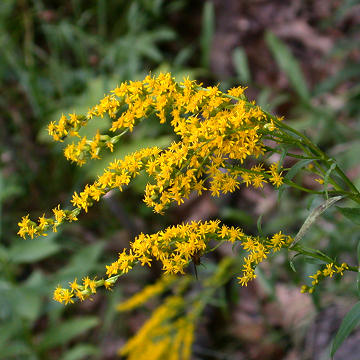

Solidago juncea - (image 1 of 6)
Taxonomy
Family: Asteraceae
Habitat
Dry, disturbed open ground and open woods, Black Oak savanna, sandy disturbed areas.
Associates
Distribution
Nova Scotia and New Brunswick west to MN, south to VA, TN, northeast MS, MO, and in mountains to northern GA and northern AL.
Morphology
Herbaceous perennial to 1.2 m from a stout, branched caudex or short rhizome; often with creeping rhizomes as well; mostly glabrous to more or less short-hirsute on the leaves or in the inflorescence. Leaves basal and cauline; basal leaves to 40 x 7.5 cm, the blades narrowly elliptic-acuminate, more or less serrate, tapering to a long petiole; basal and lower leaves often more than 2.5 cm wide, present at flowering time, 1-nerved or faintly 3-nerved. Flowers yellow; heads crowded in a paniculiform inflorescence mostly about as broad as long; inflorescence branches recurved-secund; involucres 3-5 mm; rays 7-12, minute; disk flowers 9-14; achenes short-hairy.
Notes
Flowers Early July to September
Wetland indicator: Upland
Begins blooming a little earlier than most other goldenrods. Note that the cauline leaves are not always serrate as in the pictures here but can be entire as well.
References
Gleason, Henry A. and A. Cronquist. 1991. Manual of Vascular Plants of
Northeastern United States
and Adjacent Canada. Second Ed.
The New York Botanical Garden. Bronx, NY
Swink, F. and G. Wilhelm. 1994. Plants of the Chicago Region.
Indiana Academy of Science. The Morton Arboretum. Lisle, Illinois.
|
Michael Hough © 2009 |